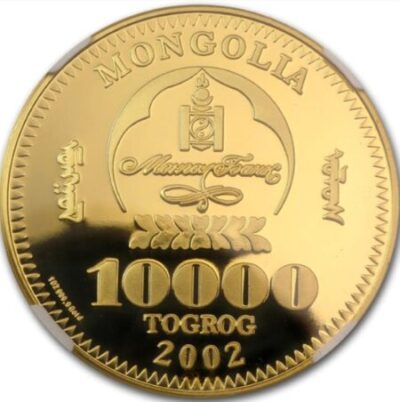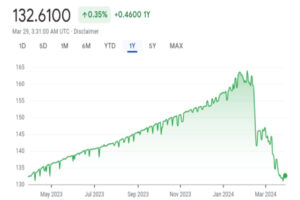Gold has long been a symbol of wealth and a hedge against economic uncertainty, but could its price realistically climb to $10,000 an ounce? While such a figure may seem ambitious, a combination of macroeconomic trends, geopolitical risks, and supply-demand dynamics could propel gold to unprecedented heights. Let us explore the factors that could drive gold to $10,000 and the timeline for such a surge.
1. Trade Wars
Trade wars, like the one escalated by Trump’s tariffs (e.g., 25% on steel and aluminum, 10-125% on Chinese goods), create global economic uncertainty. Tariffs disrupt supply chains, raise costs, and spark retaliatory measures (e.g., China’s 125% tariffs on U.S. imports). Investors often flock to gold as a safe-haven asset during such turmoil, as it’s seen as a store of value immune to inflation, currency fluctuations, or geopolitical risks.
Gold prices have already surged due to Trump’s tariffs, hitting $3,500.40/oz in April 2025, driven by fears of inflation and slower growth. If trade tensions escalate further, with broader tariffs on the EU or a breakdown in U.S.-China trade relations, safe-haven demand could intensify. A prolonged trade war could push gold to unprecedented levels, though $10,000 would require extreme, sustained panic buying.
2. Persistent Inflation and Currency Devaluation
Central banks worldwide, particularly the U.S. Federal Reserve, have struggled to tame inflation without triggering deep recessions. Since 2020, massive stimulus programs and loose monetary policies have increased money supply, eroding the purchasing power of fiat currencies. Gold, often called “sound money,” thrives in such environments as investors seek assets that hold value when paper currencies falter.
If inflation remains sticky or accelerates due to energy crises or supply chain disruptions, the U.S. dollar could weaken significantly. A weaker dollar typically boosts gold prices, as the metal is priced in USD. A loss of confidence in fiat systems could push gold to $10,000 or higher as investors flee to safe havens. For context, gold hit an all-time high of around $3,500 per ounce in April 2025 which was approximately 38.65% year-to-date performance . A sustained 20% annual increase driven by inflation could see it reach $10,000 in 6 -7 years.
3. Geopolitical Instability and Safe-Haven Demand
Geopolitical risks are at a multi-decade high. Ongoing conflicts, such as those in Ukraine and the Middle East, coupled with U.S.-China tensions over Taiwan, have heightened global uncertainty. Gold’s role as a safe-haven asset shines during such times, as investors and central banks alike stockpile it to hedge against chaos.
Central banks, particularly in non-Western nations like China, Russia, and India, have been aggressively buying gold to diversify away from U.S. dollar-dominated reserves. In 2023 and 2024, global central bank gold purchases exceeded 1,000 metric tons annually, a trend that shows no signs of slowing. If dedollarization accelerates—perhaps due to sanctions or a push for alternative reserve currencies like the yuan, gold demand could skyrocket, pushing prices toward $10,000 as nations compete for limited supply.
4. Supply Constraints and Mining Challenges
Gold is a finite resource, and new discoveries are becoming rarer and costlier. The average grade of gold ore has declined, meaning miners must process more rock to extract less gold. According to the World Gold Council, global mine production has plateaued at around 3,500 tons per year, with few major discoveries to boost output. Meanwhile, environmental regulations and rising energy costs are increasing production expenses, limiting supply growth.
On the demand side, industrial uses (e.g., electronics) and jewelry markets, particularly in Asia, continue to grow. If supply stagnates while demand rises, basic economics suggests prices will climb. A supply crunch, combined with speculative buying, could accelerate gold’s ascent to $10,000, especially if mining output fails to keep pace with central bank and investor demand.
5. Debt Crises and Financial Instability
Global debt levels are at historic highs, with the U.S. national debt surpassing $35 trillion in 2024 and global debt nearing $315 trillion, per the Institute of International Finance. Rising interest rates make servicing this debt costlier, increasing the risk of defaults or financial crises. In such scenarios, gold often outperforms other assets, as seen during the 2008 financial crisis when prices doubled within a few years.
A sovereign debt crisis or a collapse in confidence in government bonds could trigger a rush to gold. If major economies like the U.S. or Japan face credit downgrades or default risks, investors may pour money into gold, driving prices exponentially higher. Gold at $10,000 is not a fantasy if trust in debt-based systems collapses.”
6. Speculative Fever and Market Psychology
Gold’s price isn’t driven solely by fundamentals; market psychology plays a huge role. In bull markets, speculative buying by hedge funds, ETFs, and retail investors can amplify price gains. The SPDR Gold Shares ETF (GLD), for instance, saw record inflows during 2020’s gold rally. If gold breaks past psychological barriers like $5,000, FOMO (fear of missing out) could fuel a parabolic rise.
Crypto-like hype could also spill into gold markets, especially if younger investors view it as a tangible alternative to volatile digital assets. Social media platforms could amplify this trend, with influencers touting gold as “the ultimate wealth preserver.” A speculative bubble, while risky, could easily push gold to $10,000 in a short timeframe, though it might not sustain that level without fundamental backing.
Timeline and Catalysts
Reaching $10,000 per ounce would require a confluence of the above factors. A plausible timeline might be 5-10 years, assuming:
- Inflation averages 5-10% annually, eroding fiat value.
- Geopolitical shocks or dedollarization accelerate central bank buying.
- A major financial crisis unfolds, boosting safe-haven demand.
- Supply constraints tighten, and speculative fever takes hold.
Key catalysts to watch include Federal Reserve policy shifts, BRICS nations launching a gold-backed currency, or a black-swan event like a U.S. debt default. Each could act as a rocket booster for gold prices.
Gold reaching $10,000 an ounce is within the realm of possibility given current trends. Trade wars, persistent inflation, geopolitical turmoil, supply constraints, debt crises, and speculative fever could combine to drive prices to historic levels. Investors should monitor central bank actions, global debt dynamics, and credible analysts for early signals of a breakout. While $10,000 gold may sound like a dream, the economic storm clouds gathering in 2025 make it a scenario worth preparing for.





